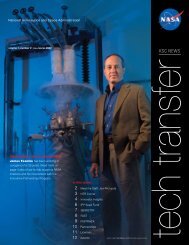2006-2007 - Kennedy Space Center Technology Transfer Office
2006-2007 - Kennedy Space Center Technology Transfer Office
2006-2007 - Kennedy Space Center Technology Transfer Office
- No tags were found...
You also want an ePaper? Increase the reach of your titles
YUMPU automatically turns print PDFs into web optimized ePapers that Google loves.
Generating Safety-Critical PLC Code From a High-Level ApplicationSoftware SpecificationThe benefits of automatic-application code generation are widely accepted withinSeamless Command and the software engineering community. These benefits include raised abstraction levelControl Coordinationof application programming, shorter product development time, lower maintenancecosts, and increased code quality and consistency. Surprisingly, code generationconcepts have not yet found wide acceptance and use in the field of programmable logic controller(PLC) software development. Software engineers at <strong>Kennedy</strong> <strong>Space</strong> <strong>Center</strong> recognized the needfor PLC code generation while developing the new ground checkout and launch processing system,called the Launch Control System (LCS). Engineers developed a process and a prototype softwaretool that automatically translates a high-level representation or specification of application softwareinto ladder logic that executes on a PLC.All the computer hardware in the LCS is planned to be commercial off the shelf (COTS), includingindustrial controllers or PLCs that are connected to the sensors and end items out in the field. Mostof the software in LCS is also planned to be COTS, with only small adapter software modules thatmust be developed in order to interface between the various COTS software products.A domain-specific language (DSL) is a programming language designed to perform tasks and to solveproblems in a particular domain, such as ground processing of launch vehicles. The LCS engineerscreated a DSL for developing test sequences of ground checkout and launch operations of futurelaunch vehicle and spacecraft elements, and they are developing a tabular specification format thatuses the DSL keywords and functions familiar to the ground and flight system users. The tabularspecification format, or tabular spec, allows most ground and flight system users to document howthe application software is intended to function and requires little or no software programmingknowledge or experience. A small sample from a prototype tabular spec application is shown inFigure 1.Figure 1. Sample of tabular spec formatted application.The LCS developers needed a mechanism or tool to translate application software from tabular specformat into PLC code to execute on the PLC platforms out in the field. The functionality of somerepresentative samples of tabular spec was manually coded into PLC ladder logic and tested with afield item simulator to verify the proper operation of the manually coded ladder logic. This manualprocess of conversion or translation from tabular spec representation to PLC ladder logic demonstratedthat translation points or patterns existed between portions of the tabular spec and portions ofthe PLC ladder logic.With the aid of these translation points, a few representative samples of the manually coded PLCladder logic were exported from the PLC coding Integrated Development Environment (IDE) asplain text. This exported text was then converted by hand into plain-text PLC code “libraries” withthe intent that a future automatic utility to translate tabular spec to ladder logic would use these PLCcode libraries. After some representative samples were translated from tabular spec to PLC ladder116 Command, Control, and Monitoring Technologies













